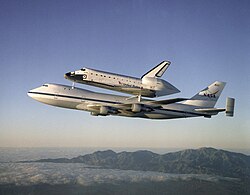
Outsize cargo is a designation given to goods of unusually large size. This term is often applied to cargo which cannot fit on standardized transport devices such as skids (pallets) or containers. This includes military and other vehicles. [1] [2]
Contents
In some cases, the cargo may be carried on the exterior atop a large cargo aircraft, such as the Space Shuttle or Buran-class spacecraft.